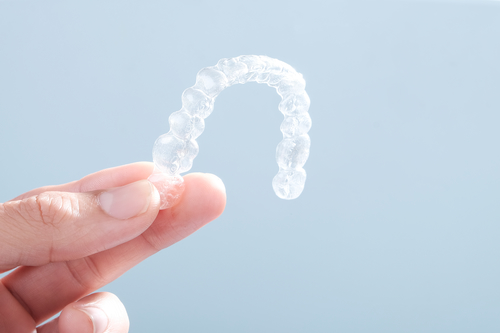Why is Gum Health Important?
When most people think about oral health, they focus on keeping their teeth clean and cavity-free. But we know you know that gum health is important. And in fact, gum...

Invisalign is a revolutionary way to get the smile you’ve always wished that you had. The treatment allows you to straighten your smile, without the hassle of metal brackets and wires, all while being virtually invisible. Just as with anything, doing your research before making a significant commitment will help you to understand your treatment and know the things you should be aware of beforehand.
In general, it’s safe to say that anytime you are moving teeth there will be some associated pain involved. Some patients report little pain during Invisalign treatment, while others report a higher amount. Overall, most people describe the pain as pressure or tenderness that tends to be at the beginning of the process, or for the first few days when wearing a new aligner.
Reduce any discomfort by:
Your Invisalign aligners will need to be changed every few weeks, and your teeth will become progressively straighter with each new set of aligners. Each aligner is designed to move teeth in 0.25mm increments. The average Invisalign treatment time takes about 12 months, and while every case is different, patients report seeing noticeable changes to their smile within the first few sets of aligners.
Stay on track for your treatment by wearing your aligners full time. Invisalign is a full-time commitment. For Invisalign to do its job, you have to wear your aligners for a minimum of 20-22 hours a day as prescribed by your provider. Aligners should only be removed for eating, or brushing and flossing.
The price for Invisalign can vary from provider to provider. There are often several factors involved in determining the office fees including the level of experience of the provider, the estimated length of treatment, the complexity of the treatment and the geographical location of the provider.
Invisalign is an excellent choice for minor or moderate orthodontic problems. If your misalignment is more complicated, it may take extremely long to align your teeth with Invisalign. It may be more efficient for you to use traditional braces if this is the case.
You may be surprised to learn how much you regularly snack throughout the day once you have to remove your aligners before doing so. Be sure to eat enough during main meals so that you don’t find yourself continually snacking; otherwise, you will be creating more work for yourself. Many patients report losing a little weight during treatment time because of this reason alone.
Treating some cases requires the use of “attachments” or “buttons” which are small tooth-colored dots of dental bonding that are placed at precise locations on specific teeth. The purpose dictates the shape and orientation of the button for reasons including:
In these situations, placing an attachment provides an anchor point, or a handle of sorts, to help direct the forces of the aligner more effectively and predictably to the tooth.
Always start at the very back tooth on the inside of your mouth. Take your finger and pull the aligner in a downwards motion to release it and make it easier to remove. Change into new aligners before bed at night, so it’s easier to get out in the morning after hours of continuous wear.
Invisalign requires patients to brush their teeth after eating or drinking anything but water. If you do not clean your teeth after eating and just put your aligners back in, you’re sealing food particles in against your teeth and under your aligners. Your aligners will then be creating a seal for bacteria on your teeth to spread, causing potential tooth decay.
Once you have progressed through the Invisalign treatment and are no longer wearing your aligners, your teeth should appear utterly straight without any crowding or noticeable gaps. Following treatment, you will be required to wear a retainer for at least 22-23 hours a day for the first six months following treatment to keep your teeth from shifting back.
Deciding to straighten your smile with Invisalign is an easy one. Contact Hoffman Dental Care to schedule a consultation appointment with our Invisalign experts today.